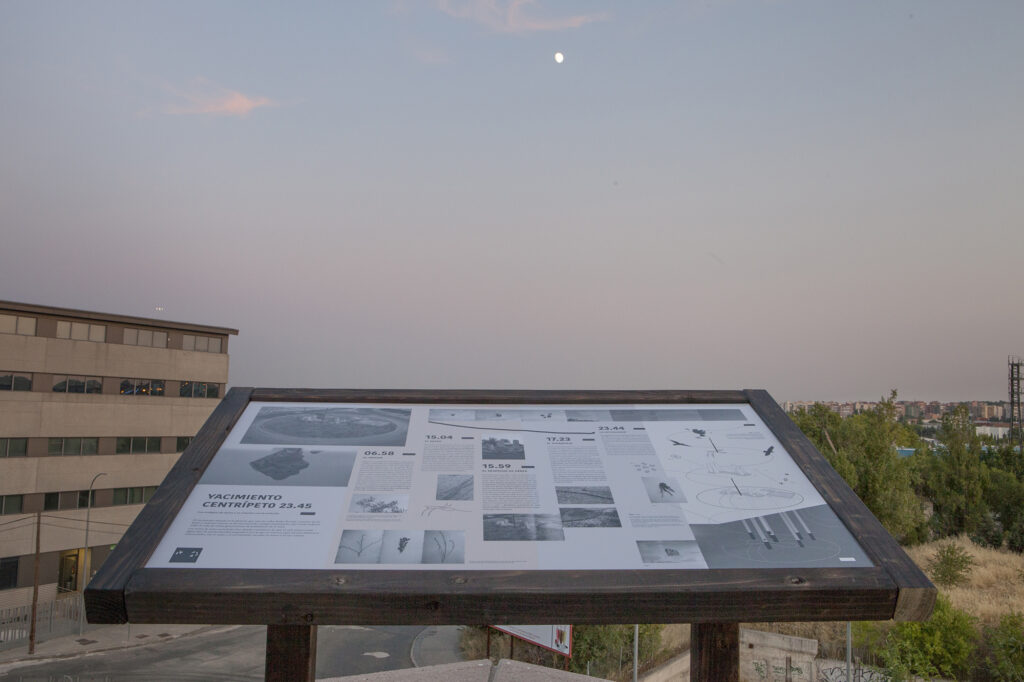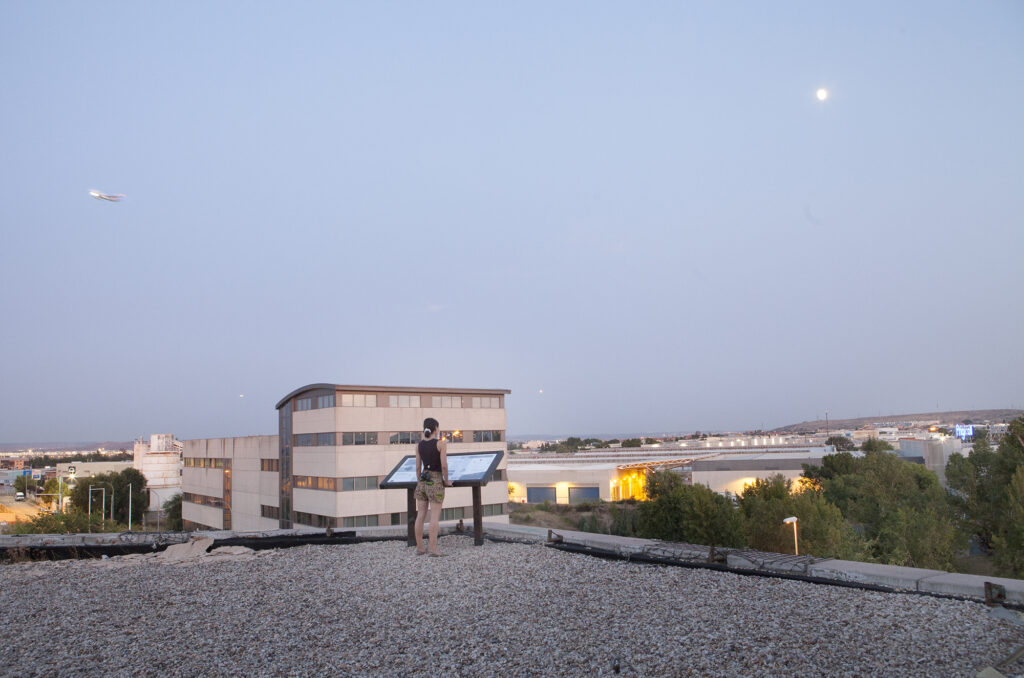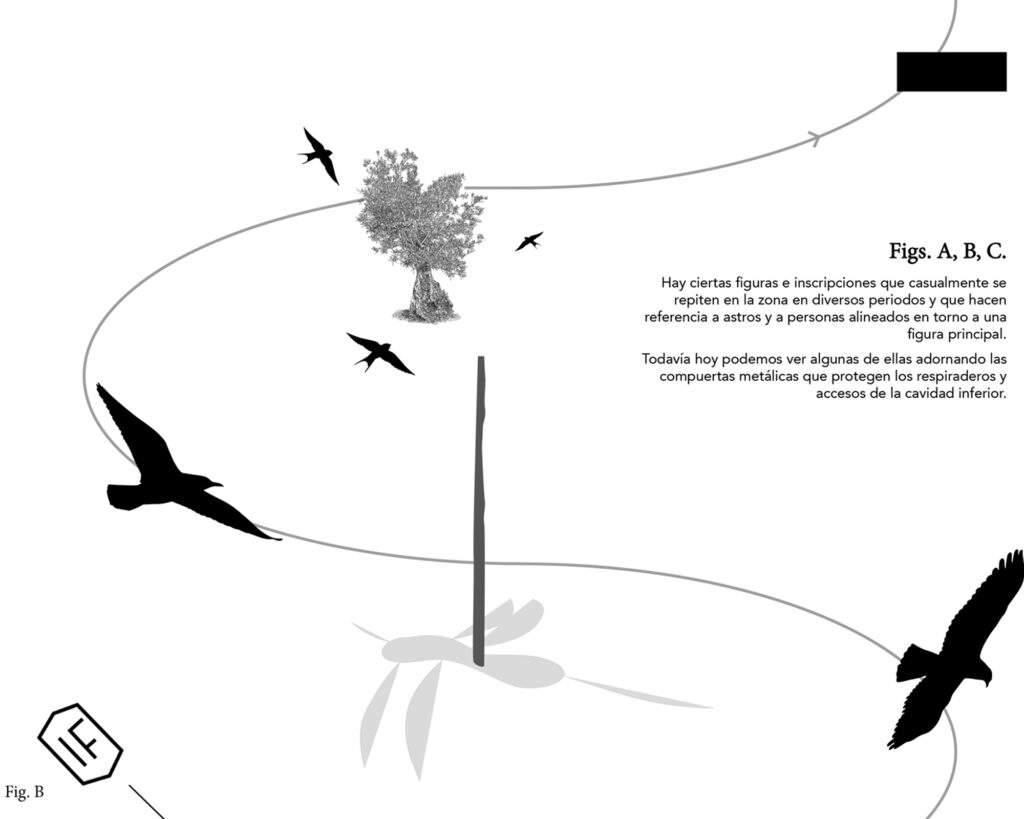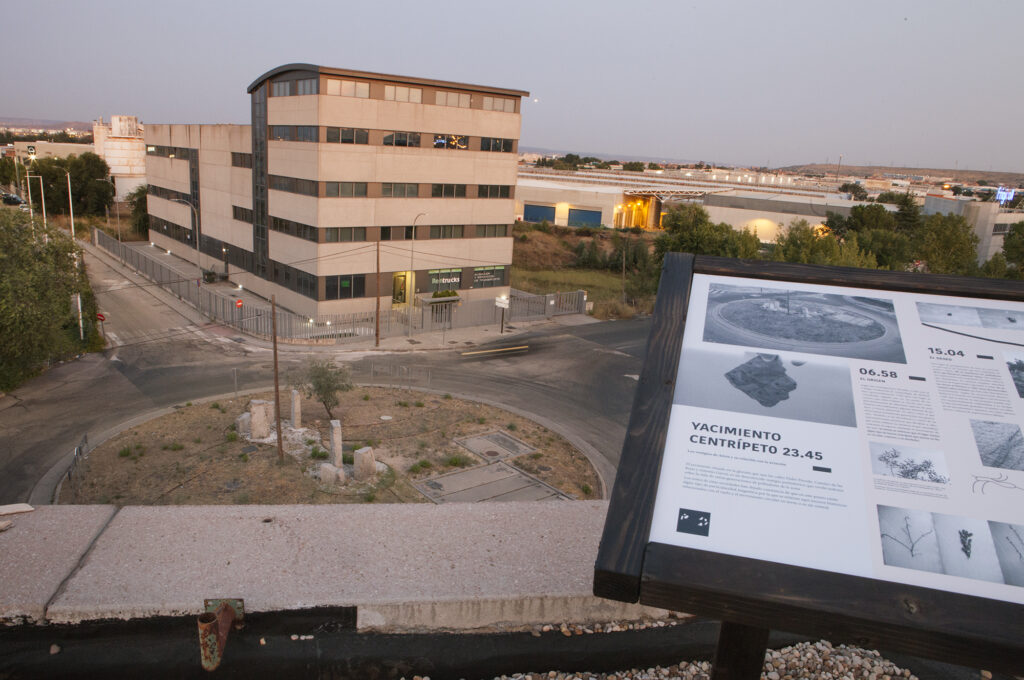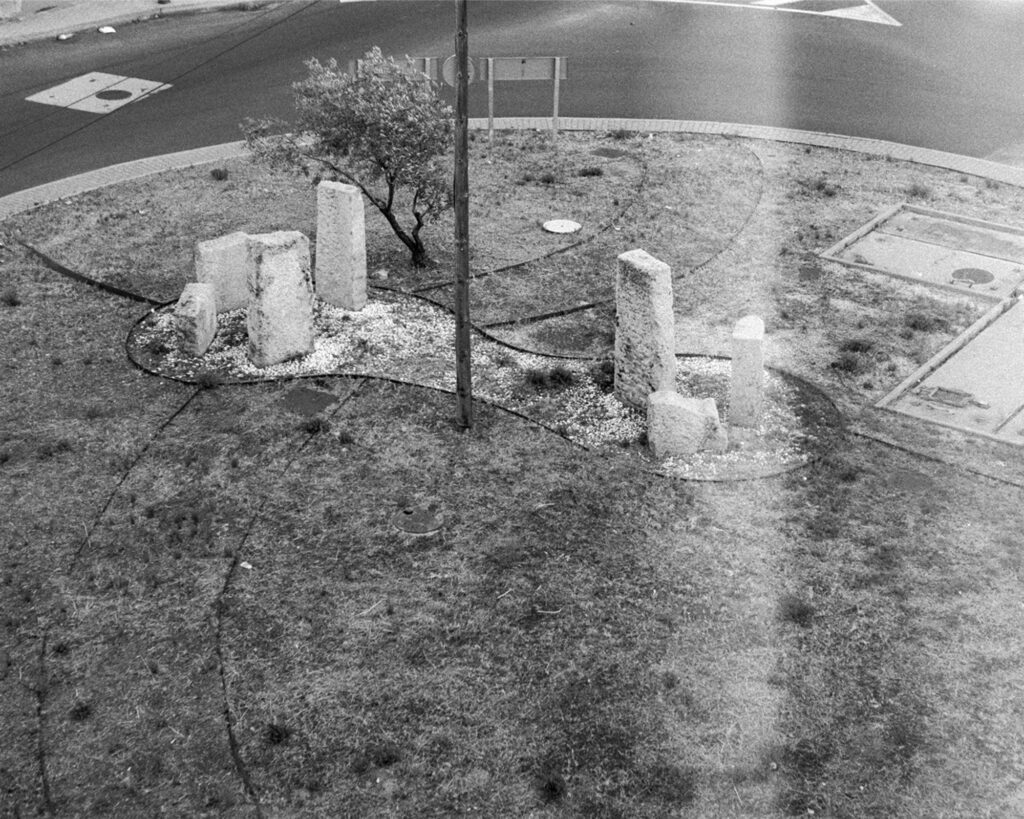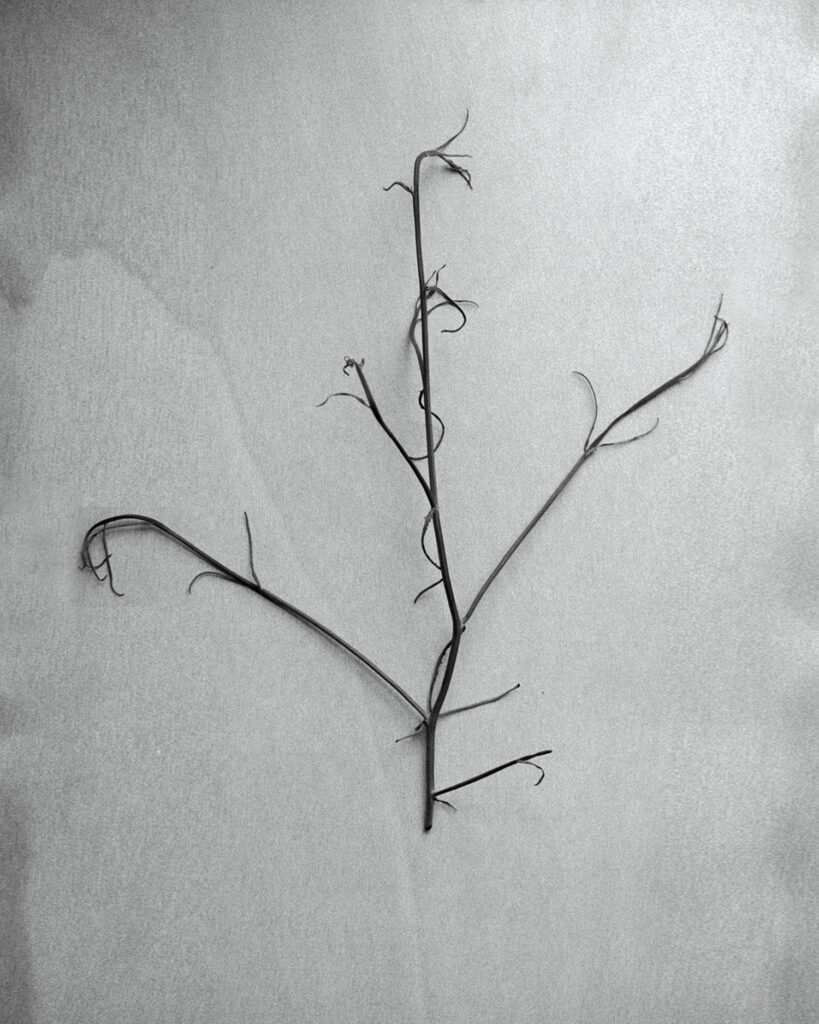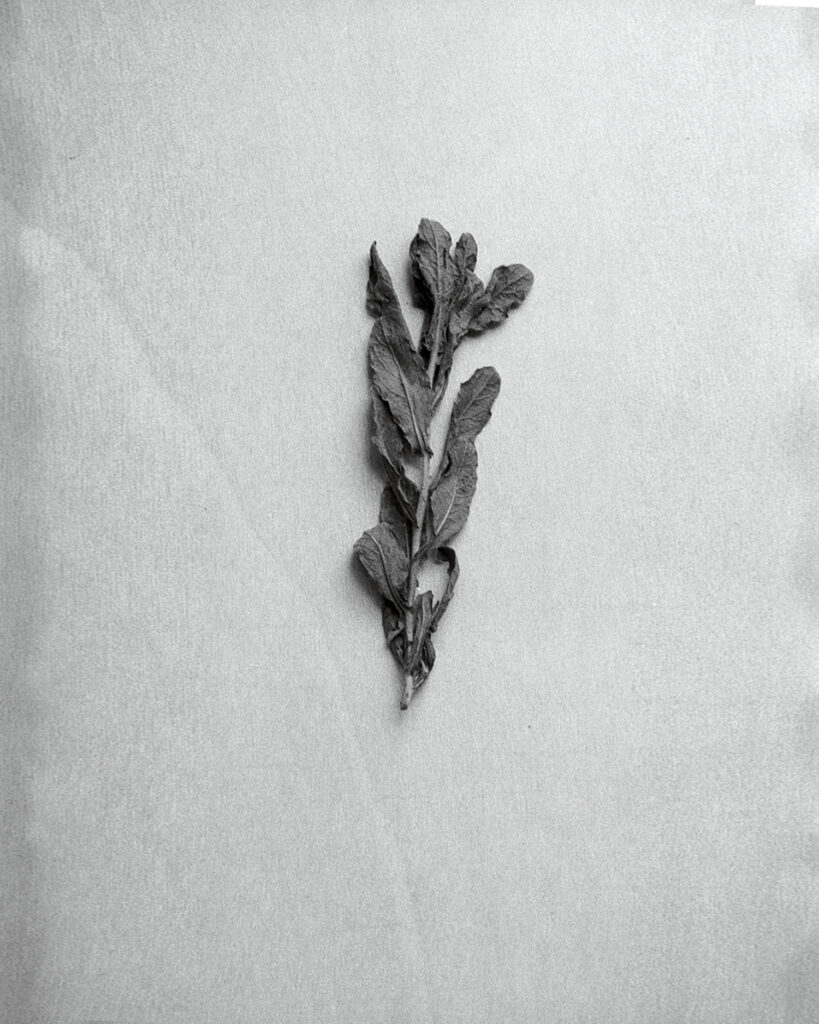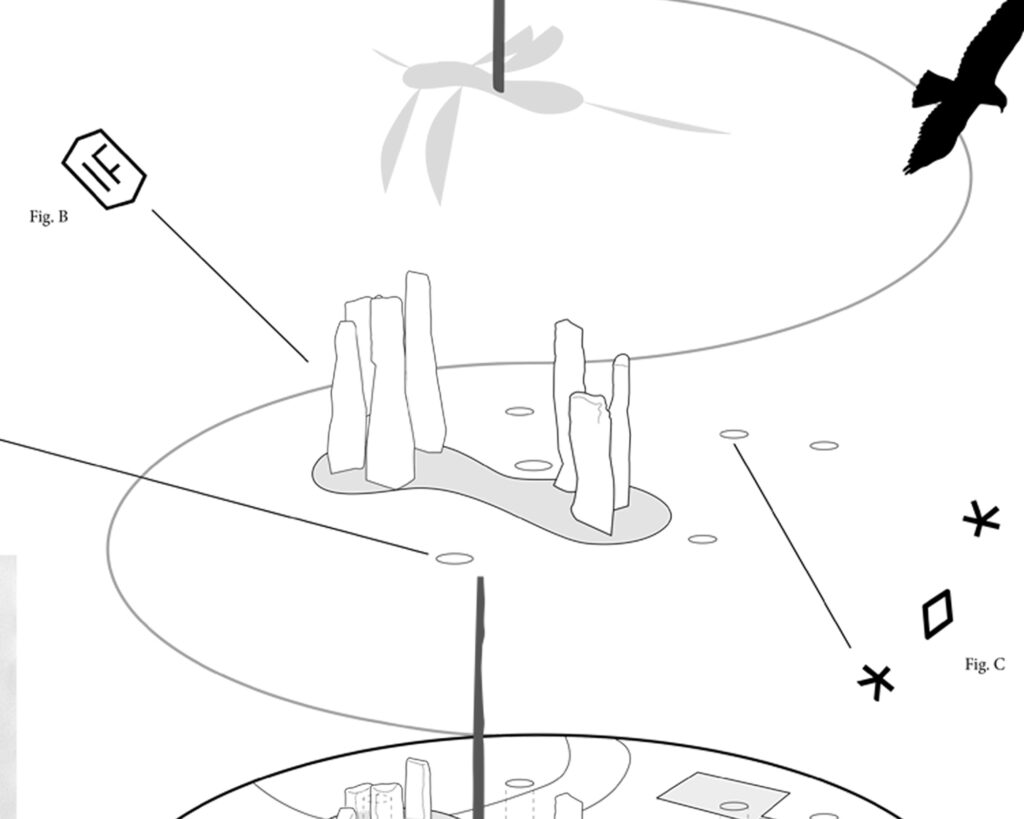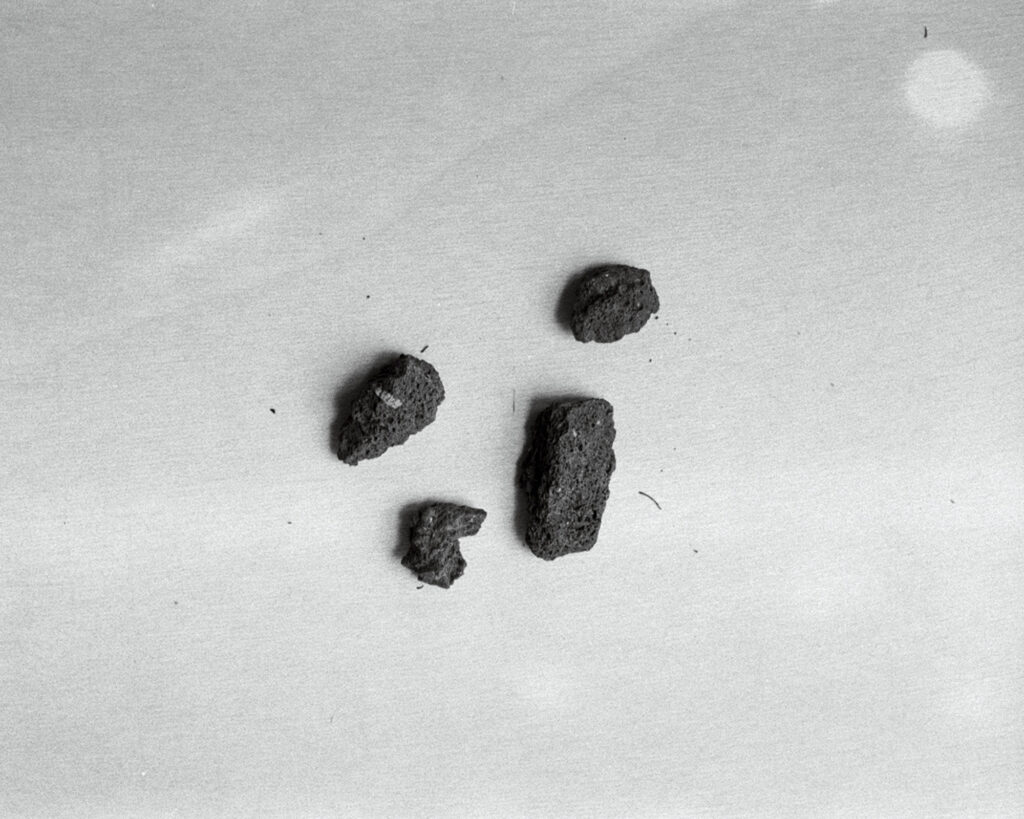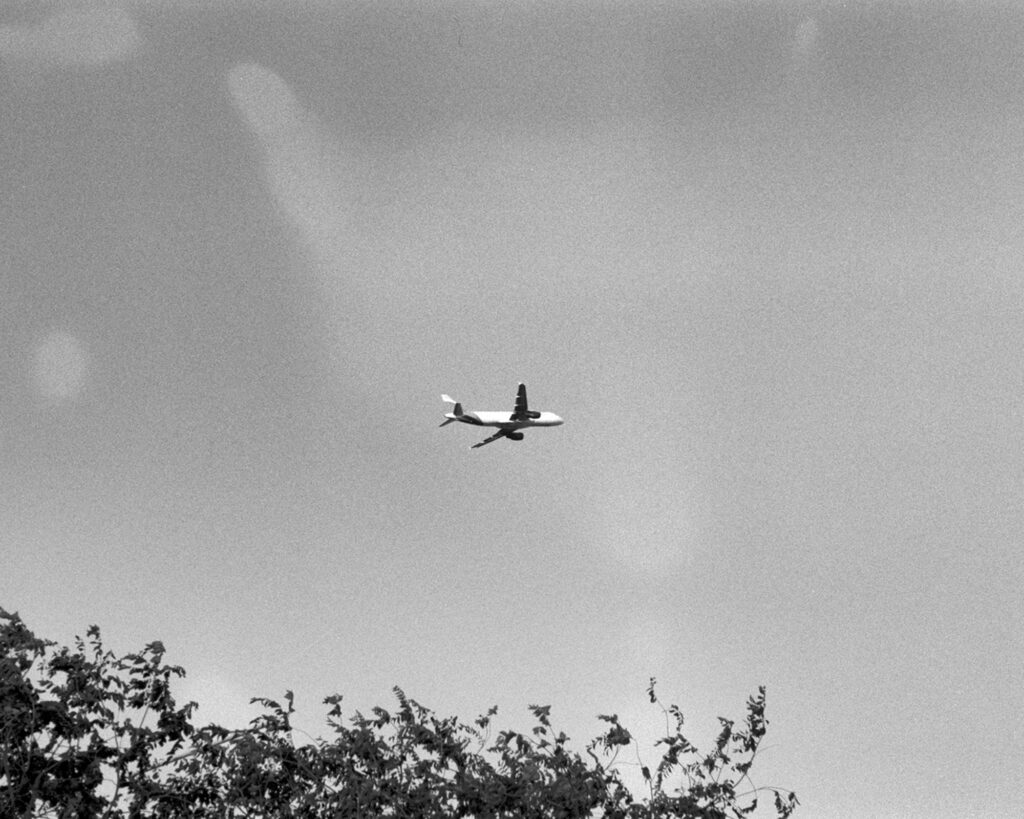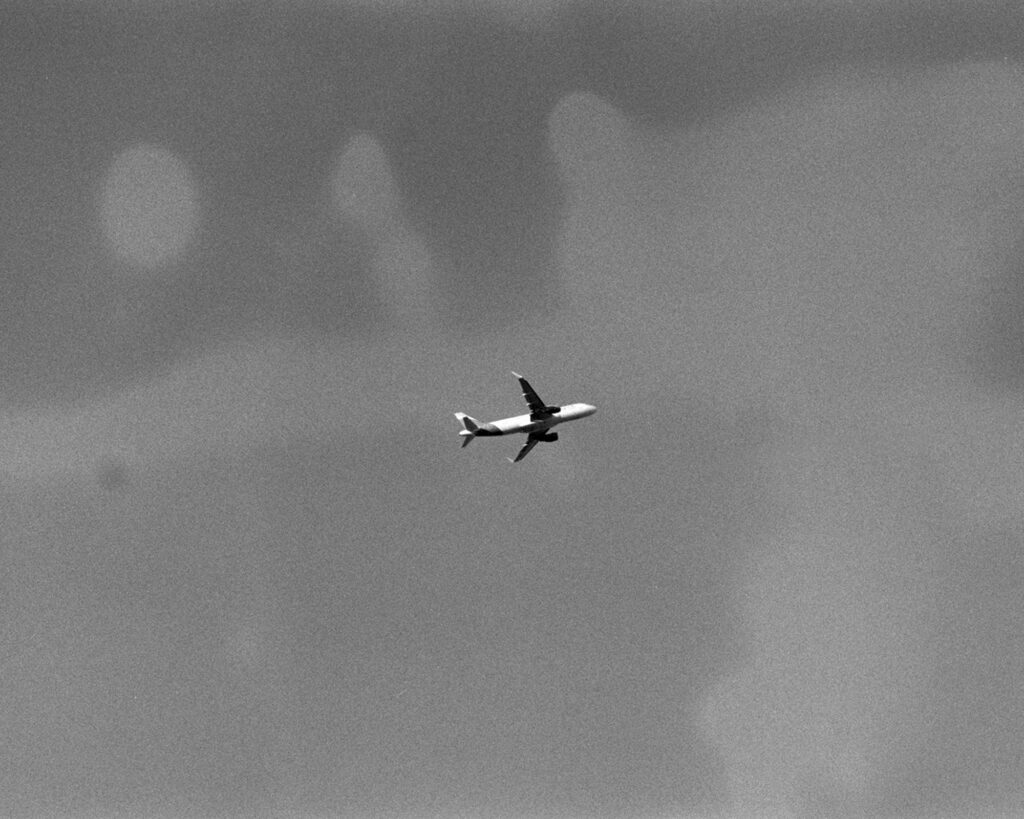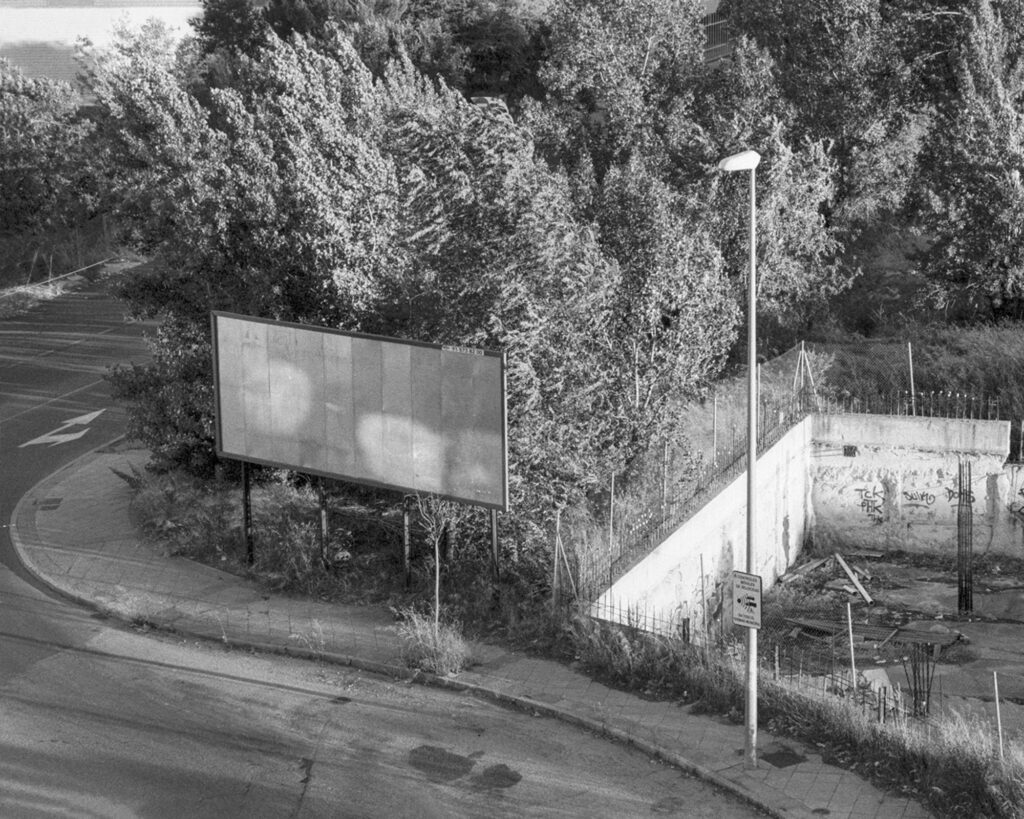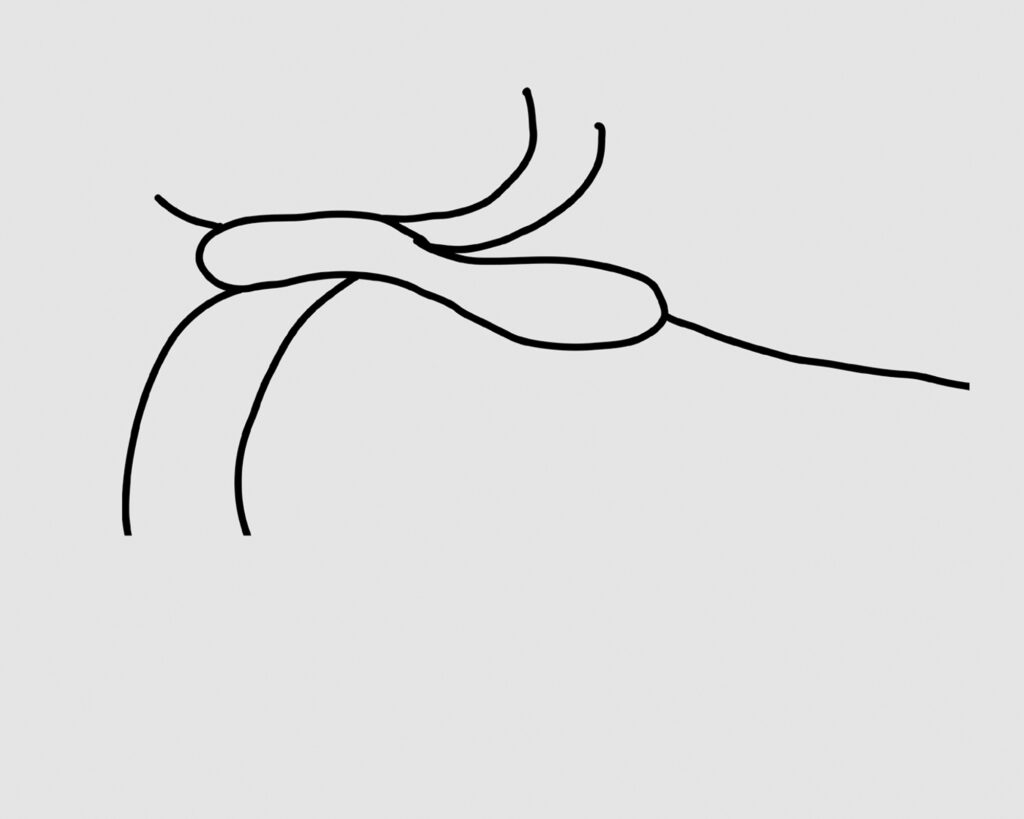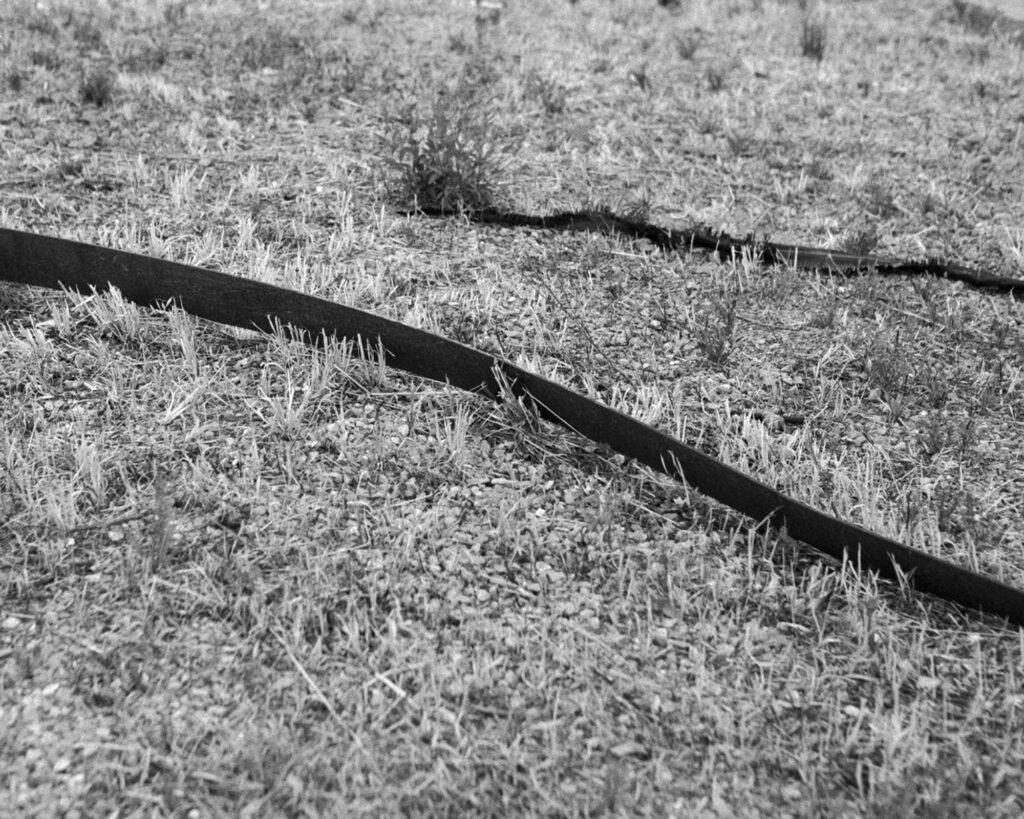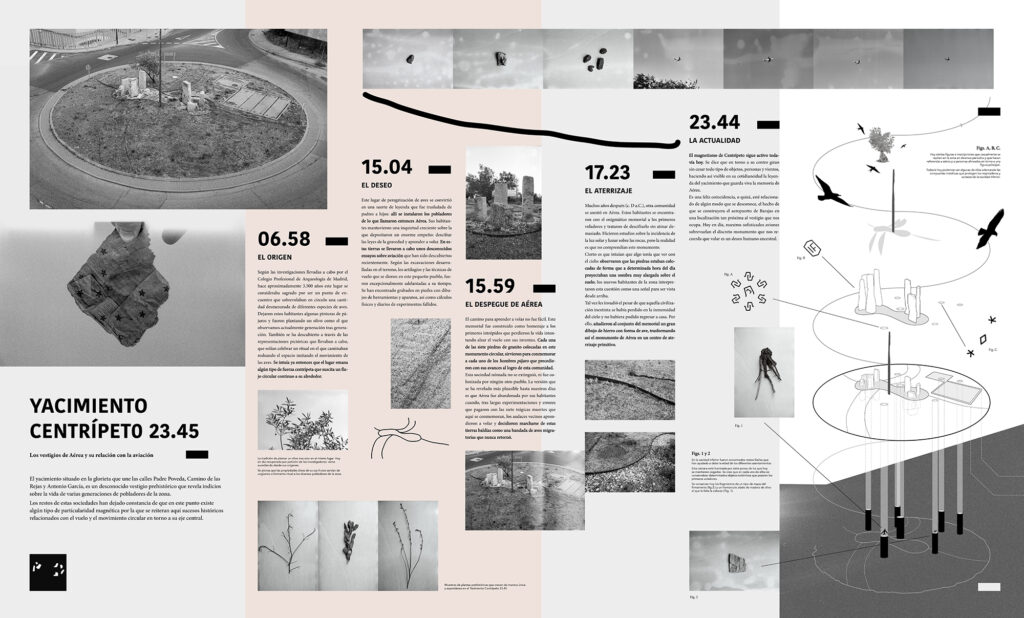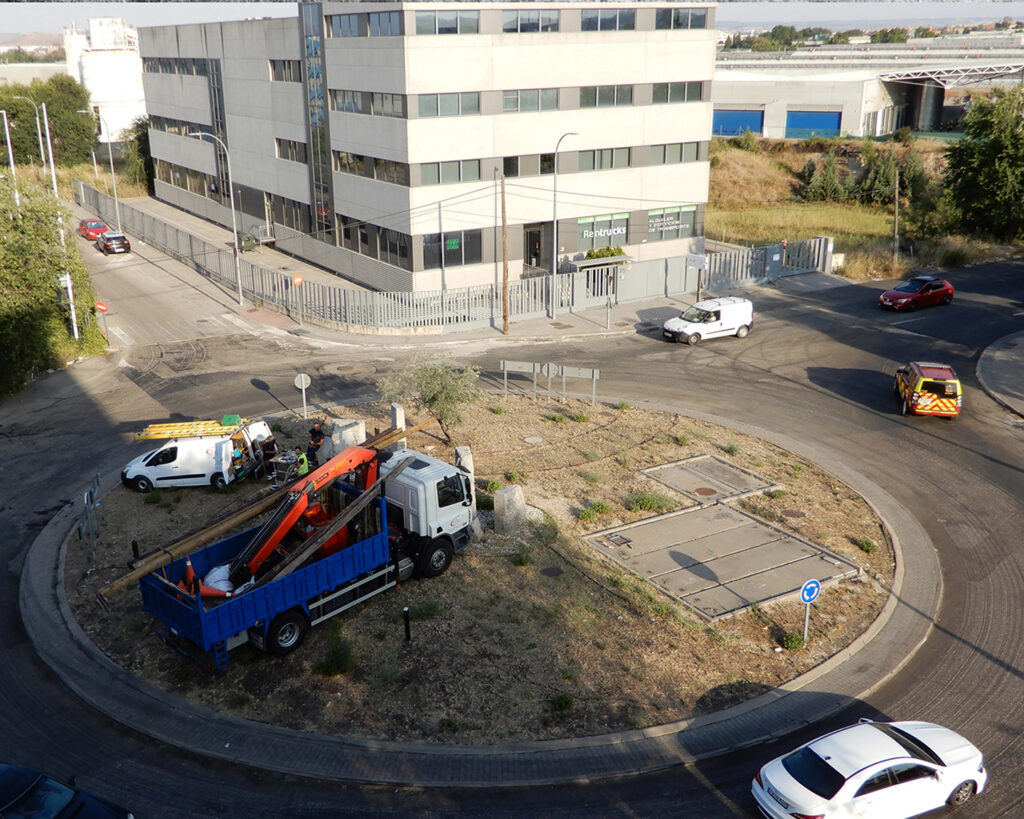Yacimiento centrípeto 23.45
[2021]
Autoras: Elsa Paricio y Florencia Rojas. Colaboración para la exposición Aragon Park
Site-specific: Tótem informativo, mesa de interpretación, yacimiento y performance
EN_
The project we present is based on the idea of treating the traffic circle in front of the building as an archaeological site. We have speculated about what may have happened there and we have created a fictitious story about the different uses that have been given to that place in an information board that forms a viewpoint to the site.
Text of the information board:
The vestiges of Aérea and its relationship with aviation
The site located in the traffic circle that joins the streets Padre Poveda, Camino de las Rejas and Antonio García, is an unknown prehistoric vestige that reveals clues about the life of several generations of settlers in the area.
The remains of these societies have left evidence that at this point there is some kind of magnetic peculiarity by which historical events related to flight and circular movement around its central axis are reiterated here.
06.58 The origin
According to the investigations carried out by the Professional Association of Archaeology of Madrid, approximately 3,500 years ago this place was considered sacred because it was a meeting point where an inordinate number of different species of birds flew in circles. These inhabitants left some paintings of birds and were planting an olive tree like the one we see today generation after generation. It has also been discovered through the pictorial representations that they carried out, that they used to celebrate a ritual in which they walked around the space imitating the movement of the birds. It was already intuited then that the place emanates some kind of centripetal force that arouses a continuous circular flow around it.
15.04 Desire
This place of bird pilgrimage became a sort of legend that was passed on from father to son: the settlers of what was then called Aerial settled there. Its inhabitants maintained a growing restlessness on which they deposited an enormous commitment: to decipher the laws of gravity and to learn to fly. In these lands were carried out some unknown tests on aviation that have been discovered recently. According to the excavations carried out in the field, the gadgets and flight techniques that took place in this small village were exceptionally ahead of their time. Stone engravings have been found with drawings of tools and apparatus, as well as physical calculations and diaries of failed experiments.
15.59 Aerial take-off
The road to learning to fly was not an easy one. This memorial was built as a tribute to the first intrepid people who lost their lives trying to take flight with their inventions. Each of the seven granite stones placed in this circular monument served to commemorate each of the birdmen who preceded the achievement of this community with their advances.
This nomadic society did not become extinct, nor was it colonized by any other people. The version that has proved most plausible to this day is that Aerial was abandoned by its inhabitants when, after long experimentations and mistakes that they paid for with the seven tragic deaths that are commemorated here, the daring neighbors learned to fly and decided to leave these wastelands as a flock of migratory birds that never returned.
17.23 The landing
Many years later (c. D B.C.), another community settled in Aeria. These inhabitants came across the enigmatic memorial to the first fliers and tried to decipher it without much success. They made studies on the incidence of sunlight and moonlight on the rocks, but the reality is that they did not understand this monument.
It is true that they sensed that something had to do with the sky: they observed that the stones were placed in such a way that at a certain time of the day they projected a very long shadow on the ground; the new inhabitants of the area interpreted this as a sign to be seen from above.
Perhaps they were overcome by the regret that the extinct civilization had been lost in the immensity of the sky and would not have been able to return home. Therefore, they added a large iron drawing in the shape of a bird to the memorial, thus transforming the Aerial monument into a primitive landing center.
23.44 The present day
The magnetism of Centripetus is still active today. It is said that all kinds of objects, people and winds are constantly revolving around its center, thus making visible in its daily life the legend of the site that keeps alive the memory of Aerea.
It is a happy coincidence, or perhaps, it is related in some unknown way, the fact that the Barajas airport was built in a location so close to the vestige that concerns us. Today, our sophisticated airplanes fly over the discreet monument that reminds us that flying is an ancestral human desire".
ES_
El proyecto que presentamos parte de la idea de tratar la glorieta que hay delante del edificio como un yacimiento arqueológico. Hemos especulado sobre qué puede haber ocurrido allí y hemos creado un relato ficticio sobre los distintos usos que se le ha dado a ese lugar en una mesa de interpretación que conforma un mirador hacia el yacimiento.
Texto de la mesa de interpretación:
Los vestigios de Aérea y su relación con la aviación
El yacimiento situado en la glorieta que une las calles Padre Poveda, Camino de las Rejas y Antonio García, es un desconocido vestigio prehistórico que revela indicios sobre la vida de varias generaciones de pobladores de la zona.
Los restos de estas sociedades han dejado constancia de que en este punto existe algún tipo de particularidad magnética por la que se reiteran aquí sucesos históricos relacionados con el vuelo y el movimiento circular en torno a su eje central.
06.58 El origen
Según las investigaciones llevadas a cabo por el Colegio Profesional de Arqueología de Madrid, hace aproximadamente 3.500 años este lugar se consideraba sagrado por ser un punto de encuentro que sobrevolaban en círculo una cantidad desmesurada de diferentes especies de aves. Dejaron estos habitantes algunas pinturas de pájaros y fueron plantando un olivo como el que observamos actualmente generación tras generación. También se ha descubierto a través de las representaciones pictóricas que llevaban a cabo, que solían celebrar un ritual en el que caminaban rodeando el espacio imitando el movimiento de las aves. Se intuía ya entonces que el lugar emana algún tipo de fuerza centrípeta que suscita un flujo circular continuo a su alrededor.
15.04 El deseo
Este lugar de peregrinación de aves se convirtió en una suerte de leyenda que fue trasladada de padres a hijos: allí se instalaron los pobladores de lo que llamaron entonces Aérea. Sus habitantes mantuvieron una inquietud creciente sobre la que depositaron un enorme empeño: descifrar las leyes de la gravedad y aprender a volar. En estas tierras se llevaron a cabo unos desconocidos ensayos sobre aviación que han sido descubiertos recientemente. Según las excavaciones desarrolladas en el terreno, los artilugios y las técnicas de vuelo que se dieron en este pequeño pueblo, fueron excepcionalmente adelantadas a su tiempo. Se han encontrado grabados en piedra con dibujos de herramientas y aparatos, así como cálculos físicos y diarios de experimentos fallidos.
15.59 El despegue de aérea
El camino para aprender a volar no fue fácil. Este memorial fue construido como homenaje a los primeros intrépidos que perdieron la vida intentando alzar el vuelo con sus inventos. Cada una de las siete piedras de granito colocadas en este monumento circular, sirvieron para conmemorar a cada uno de los hombres pájaro que precedieron con sus avances al logro de esta comunidad.
Esta sociedad nómada no se extinguió, ni fue colonizada por ningún otro pueblo. La versión que se ha revelado más plausible hasta nuestros días es que Aérea fue abandonada por sus habitantes cuando, tras largas experimentaciones y errores que pagaron con las siete trágicas muertes que aquí se conmemoran, los audaces vecinos aprendieron a volar y decidieron marcharse de estas tierras baldías como una bandada de aves migratorias que nunca retornó.
17.23 El aterrizaje
Muchos años después (c. D a.C.), otra comunidad se asentó en Aérea. Estos habitantes se encontraron con el enigmático memorial a los primeros voladores y trataron de descifrarlo sin atinar demasiado. Hicieron estudios sobre la incidencia de la luz solar y lunar sobre las rocas, pero la realidad es que no comprendían este monumento.
Cierto es que intuían que algo tenía que ver con el cielo: observaron que las piedras estaban colocadas de forma que a determinada hora del día proyectaban una sombra muy alargada sobre el suelo; los nuevos habitantes de la zona interpretaron esta cuestión como una señal para ser vista desde arriba.
Tal vez les invadió el pesar de que aquella civilización inextinta se había perdido en la inmensidad del cielo y no hubiera podido regresar a casa. Por ello, añadieron al conjunto del memorial un gran dibujo de hierro con forma de ave, trasformando así el monumento de Aérea en un centro de aterrizaje primitivo.
23.44 La actualidad
El magnetismo de Centrípeto sigue activo todavía hoy. Se dice que en torno a su centro giran sin cesar todo tipo de objetos, personas y vientos, haciendo así visible en su cotidianeidad la leyenda del yacimiento que guarda viva la memoria de Aérea.
Es una feliz coincidencia, o quizá, esté relacionado de algún modo que se desconoce, el hecho de que se construyera el aeropuerto de Barajas en una localización tan próxima al vestigio que nos ocupa. Hoy en día, nuestros sofisticados aviones sobrevuelan el discreto monumento que nos recuerda que volar es un deseo humano ancestral.
Site-specific: Tótem informativo, mesa de interpretación, yacimiento y performance
EN_
The project we present is based on the idea of treating the traffic circle in front of the building as an archaeological site. We have speculated about what may have happened there and we have created a fictitious story about the different uses that have been given to that place in an information board that forms a viewpoint to the site.
Text of the information board:
The vestiges of Aérea and its relationship with aviation
The site located in the traffic circle that joins the streets Padre Poveda, Camino de las Rejas and Antonio García, is an unknown prehistoric vestige that reveals clues about the life of several generations of settlers in the area.
The remains of these societies have left evidence that at this point there is some kind of magnetic peculiarity by which historical events related to flight and circular movement around its central axis are reiterated here.
06.58 The origin
According to the investigations carried out by the Professional Association of Archaeology of Madrid, approximately 3,500 years ago this place was considered sacred because it was a meeting point where an inordinate number of different species of birds flew in circles. These inhabitants left some paintings of birds and were planting an olive tree like the one we see today generation after generation. It has also been discovered through the pictorial representations that they carried out, that they used to celebrate a ritual in which they walked around the space imitating the movement of the birds. It was already intuited then that the place emanates some kind of centripetal force that arouses a continuous circular flow around it.
15.04 Desire
This place of bird pilgrimage became a sort of legend that was passed on from father to son: the settlers of what was then called Aerial settled there. Its inhabitants maintained a growing restlessness on which they deposited an enormous commitment: to decipher the laws of gravity and to learn to fly. In these lands were carried out some unknown tests on aviation that have been discovered recently. According to the excavations carried out in the field, the gadgets and flight techniques that took place in this small village were exceptionally ahead of their time. Stone engravings have been found with drawings of tools and apparatus, as well as physical calculations and diaries of failed experiments.
15.59 Aerial take-off
The road to learning to fly was not an easy one. This memorial was built as a tribute to the first intrepid people who lost their lives trying to take flight with their inventions. Each of the seven granite stones placed in this circular monument served to commemorate each of the birdmen who preceded the achievement of this community with their advances.
This nomadic society did not become extinct, nor was it colonized by any other people. The version that has proved most plausible to this day is that Aerial was abandoned by its inhabitants when, after long experimentations and mistakes that they paid for with the seven tragic deaths that are commemorated here, the daring neighbors learned to fly and decided to leave these wastelands as a flock of migratory birds that never returned.
17.23 The landing
Many years later (c. D B.C.), another community settled in Aeria. These inhabitants came across the enigmatic memorial to the first fliers and tried to decipher it without much success. They made studies on the incidence of sunlight and moonlight on the rocks, but the reality is that they did not understand this monument.
It is true that they sensed that something had to do with the sky: they observed that the stones were placed in such a way that at a certain time of the day they projected a very long shadow on the ground; the new inhabitants of the area interpreted this as a sign to be seen from above.
Perhaps they were overcome by the regret that the extinct civilization had been lost in the immensity of the sky and would not have been able to return home. Therefore, they added a large iron drawing in the shape of a bird to the memorial, thus transforming the Aerial monument into a primitive landing center.
23.44 The present day
The magnetism of Centripetus is still active today. It is said that all kinds of objects, people and winds are constantly revolving around its center, thus making visible in its daily life the legend of the site that keeps alive the memory of Aerea.
It is a happy coincidence, or perhaps, it is related in some unknown way, the fact that the Barajas airport was built in a location so close to the vestige that concerns us. Today, our sophisticated airplanes fly over the discreet monument that reminds us that flying is an ancestral human desire".
ES_
El proyecto que presentamos parte de la idea de tratar la glorieta que hay delante del edificio como un yacimiento arqueológico. Hemos especulado sobre qué puede haber ocurrido allí y hemos creado un relato ficticio sobre los distintos usos que se le ha dado a ese lugar en una mesa de interpretación que conforma un mirador hacia el yacimiento.
Texto de la mesa de interpretación:
Los vestigios de Aérea y su relación con la aviación
El yacimiento situado en la glorieta que une las calles Padre Poveda, Camino de las Rejas y Antonio García, es un desconocido vestigio prehistórico que revela indicios sobre la vida de varias generaciones de pobladores de la zona.
Los restos de estas sociedades han dejado constancia de que en este punto existe algún tipo de particularidad magnética por la que se reiteran aquí sucesos históricos relacionados con el vuelo y el movimiento circular en torno a su eje central.
06.58 El origen
Según las investigaciones llevadas a cabo por el Colegio Profesional de Arqueología de Madrid, hace aproximadamente 3.500 años este lugar se consideraba sagrado por ser un punto de encuentro que sobrevolaban en círculo una cantidad desmesurada de diferentes especies de aves. Dejaron estos habitantes algunas pinturas de pájaros y fueron plantando un olivo como el que observamos actualmente generación tras generación. También se ha descubierto a través de las representaciones pictóricas que llevaban a cabo, que solían celebrar un ritual en el que caminaban rodeando el espacio imitando el movimiento de las aves. Se intuía ya entonces que el lugar emana algún tipo de fuerza centrípeta que suscita un flujo circular continuo a su alrededor.
15.04 El deseo
Este lugar de peregrinación de aves se convirtió en una suerte de leyenda que fue trasladada de padres a hijos: allí se instalaron los pobladores de lo que llamaron entonces Aérea. Sus habitantes mantuvieron una inquietud creciente sobre la que depositaron un enorme empeño: descifrar las leyes de la gravedad y aprender a volar. En estas tierras se llevaron a cabo unos desconocidos ensayos sobre aviación que han sido descubiertos recientemente. Según las excavaciones desarrolladas en el terreno, los artilugios y las técnicas de vuelo que se dieron en este pequeño pueblo, fueron excepcionalmente adelantadas a su tiempo. Se han encontrado grabados en piedra con dibujos de herramientas y aparatos, así como cálculos físicos y diarios de experimentos fallidos.
15.59 El despegue de aérea
El camino para aprender a volar no fue fácil. Este memorial fue construido como homenaje a los primeros intrépidos que perdieron la vida intentando alzar el vuelo con sus inventos. Cada una de las siete piedras de granito colocadas en este monumento circular, sirvieron para conmemorar a cada uno de los hombres pájaro que precedieron con sus avances al logro de esta comunidad.
Esta sociedad nómada no se extinguió, ni fue colonizada por ningún otro pueblo. La versión que se ha revelado más plausible hasta nuestros días es que Aérea fue abandonada por sus habitantes cuando, tras largas experimentaciones y errores que pagaron con las siete trágicas muertes que aquí se conmemoran, los audaces vecinos aprendieron a volar y decidieron marcharse de estas tierras baldías como una bandada de aves migratorias que nunca retornó.
17.23 El aterrizaje
Muchos años después (c. D a.C.), otra comunidad se asentó en Aérea. Estos habitantes se encontraron con el enigmático memorial a los primeros voladores y trataron de descifrarlo sin atinar demasiado. Hicieron estudios sobre la incidencia de la luz solar y lunar sobre las rocas, pero la realidad es que no comprendían este monumento.
Cierto es que intuían que algo tenía que ver con el cielo: observaron que las piedras estaban colocadas de forma que a determinada hora del día proyectaban una sombra muy alargada sobre el suelo; los nuevos habitantes de la zona interpretaron esta cuestión como una señal para ser vista desde arriba.
Tal vez les invadió el pesar de que aquella civilización inextinta se había perdido en la inmensidad del cielo y no hubiera podido regresar a casa. Por ello, añadieron al conjunto del memorial un gran dibujo de hierro con forma de ave, trasformando así el monumento de Aérea en un centro de aterrizaje primitivo.
23.44 La actualidad
El magnetismo de Centrípeto sigue activo todavía hoy. Se dice que en torno a su centro giran sin cesar todo tipo de objetos, personas y vientos, haciendo así visible en su cotidianeidad la leyenda del yacimiento que guarda viva la memoria de Aérea.
Es una feliz coincidencia, o quizá, esté relacionado de algún modo que se desconoce, el hecho de que se construyera el aeropuerto de Barajas en una localización tan próxima al vestigio que nos ocupa. Hoy en día, nuestros sofisticados aviones sobrevuelan el discreto monumento que nos recuerda que volar es un deseo humano ancestral.
